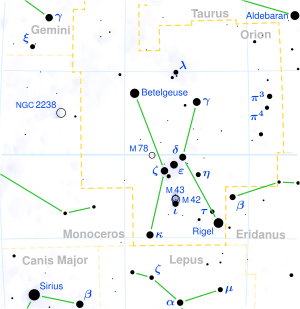Pi3 Orionis

| |
| Observation data Epoch J2000.0 Equinox J2000.0 | |
|---|---|
| Constellation | Orion |
| Right ascension | 04h 49m 50.41091s[1] |
| Declination | +06° 57′ 40.5883″[1] |
| Apparent magnitude (V) | 3.16[2] |
| Characteristics | |
| Spectral type | F6 V[2] |
| U−B color index | +0.00[2] |
| B−V color index | +0.46[2] |
| Variable type | Suspected[3] |
| Astrometry | |
| Radial velocity (Rv) | 24.1[4] km/s |
| Proper motion (μ) | RA: 464.06[1] mas/yr Dec.: 11.21[1] mas/yr |
| Parallax (π) | 123.94 ± 0.17[1] mas |
| Distance | 26.32 ± 0.04 ly (8.07 ± 0.01 pc) |
| Absolute magnitude (MV) | 3.65[5] |
| Details | |
| Mass | 1.236[6] M☉ |
| Radius | 1.323 ± 0.004[7] R☉ |
| Luminosity | 2.822 ± 0.030[7] L☉ |
| Surface gravity (log g) | 4.4[8] cgs |
| Temperature | 6,516 ± 19[7] K |
| Metallicity [Fe/H] | 0.02[8] dex |
| Rotational velocity (v sin i) | 17[9] km/s |
| Age | 1.4[5] Gyr |
| Other designations | |
Pi3 Orionis (π3 Ori, π3 Orionis) is the Bayer designation for a star in the equatorial constellation of Orion. It has the traditional name of Tabit[11] and the Flamsteed designation 1 Orionis. At an apparent visual magnitude of 3.16,[2] it is readily visible to the naked eye. Pi3 Orionis is the brightest star in the lion's hide (or shield) that Orion is holding. The distance to this star, as measured using the parallax technique, is 26.32 light-years (8.07 parsecs).[1] Though no extrasolar planets have been observed around Pi3 Orionis, the star is considered a prime location for planets as small as the Earth.
Pi3 Orionis is a main-sequence star of spectral type F6 V. Since 1943, the spectrum of this star has served as one of the stable anchor points by which other stars are classified.[12] Compared to the Sun, it has about 124%[6] of the mass, 132% of the radius, and nearly 3 times the luminosity.[7] This energy is being radiated from the star's outer atmosphere at an effective temperature of 6,516 K,[7] giving it the yellow-white glow of an F-type star. Pi3 Orionis is most likely single; a nearby star is probably an optical companion.[13]
Although a periodicity of 73.26 days has been observed in the star's radial velocity, it seems likely to be bound more to stellar activity than to a planetary object in close orbit. No substellar companion has been detected so far around Pi3 Orionis and the McDonald Observatory team has set limits to the presence of one or more planets[14] with masses between 0.84 and 46.7 Jupiter masses and average separations spanning between 0.05 and 5.2 astronomical units. Thus, so far it appears that an Earth-like planet could easily orbit the star without any complications caused by a gravitationally perturbing body.
See also
References
- 1 2 3 4 5 6 van Leeuwen, F. (November 2007), "Validation of the new Hipparcos reduction", Astronomy and Astrophysics, 474 (2): 653–664, arXiv:0708.1752
 , Bibcode:2007A&A...474..653V, doi:10.1051/0004-6361:20078357.
, Bibcode:2007A&A...474..653V, doi:10.1051/0004-6361:20078357. - 1 2 3 4 5 Johnson, H. L.; Morgan, W. W. (1953), "Fundamental stellar photometry for standards of spectral type on the revised system of the Yerkes spectral atlas", Astrophysical Journal, 117: 313–352, Bibcode:1953ApJ...117..313J, doi:10.1086/145697.
- ↑ Kukarkin, B. V.; et al. (1981), Nachrichtenblatt der Vereinigung der Sternfreunde e.V. (Catalogue of suspected variable stars), Moscow: Academy of Sciences USSR Shternberg, Bibcode:1981NVS...C......0K.
- ↑ Evans, D. S. (June 20–24, 1966), "The Revision of the General Catalogue of Radial Velocities", in Batten, Alan Henry; Heard, John Frederick, Determination of Radial Velocities and their Applications, Proceedings from IAU Symposium no. 30, University of Toronto: International Astronomical Union, Bibcode:1967IAUS...30...57E.
- 1 2 Holmberg, J.; Nordström, B.; Andersen, J. (July 2009), "The Geneva-Copenhagen survey of the solar neighbourhood. III. Improved distances, ages, and kinematics", Astronomy and Astrophysics Supplement Series, 501 (3): 941–947, arXiv:0811.3982
 , Bibcode:2009A&A...501..941H, doi:10.1051/0004-6361/200811191. Note: see VizieR catalogue V/130.
, Bibcode:2009A&A...501..941H, doi:10.1051/0004-6361/200811191. Note: see VizieR catalogue V/130. - 1 2 Takeda, G.; et al. (2007), "Stellar parameters of nearby cool stars. II. Physical properties of ~1000 cool stars from the SPOCS catalog", Astrophysical Journal Supplement Series, 168: 297–318, Bibcode:2008yCat..21680297T, doi:10.1086/509763 Note: see VizieR catalogue J/ApJS/168/297.
- 1 2 3 4 5 Boyajian, Tabetha S.; et al. (February 2012), "Stellar Diameters and Temperatures. I. Main-sequence A, F, and G Stars", The Astrophysical Journal, 746 (1): 101, arXiv:1112.3316
 , Bibcode:2012ApJ...746..101B, doi:10.1088/0004-637X/746/1/101. See Table 10.
, Bibcode:2012ApJ...746..101B, doi:10.1088/0004-637X/746/1/101. See Table 10. - 1 2 Kuroczkin, D.; Wiszniewski, A. (1997), "The problem of iron abundance in the SMR stars.", Acta Astronomica, 27: 145–150, Bibcode:1977AcA....27..145K.
- ↑ Bernacca, P. L.; Perinotto, M. (1970), "A catalogue of stellar rotational velocities", Contributi Osservatorio Astronomico di Padova in Asiago, 239 (1), Bibcode:1970CoAsi.239....1B.
- ↑ "1 Ori -- Variable Star", SIMBAD Astronomical Object Database, Centre de Données astronomiques de Strasbourg, retrieved 2011-01-07
- ↑ Moore, Patrick; Rees, Robin (2011), Patrick Moore's Data Book of Astronomy (2nd ed.), Cambridge University Press, p. 460, ISBN 0521899354
- ↑ Garrison, R. F. (December 1993), "Anchor Points for the MK System of Spectral Classification", Bulletin of the American Astronomical Society, 25: 1319, Bibcode:1993AAS...183.1710G, retrieved 2012-02-04
- ↑ Eggleton, P. P.; Tokovinin, A. A. (September 2008), "A catalogue of multiplicity among bright stellar systems", Monthly Notices of the Royal Astronomical Society, 389 (2): 869–879, arXiv:0806.2878
 , Bibcode:2008MNRAS.389..869E, doi:10.1111/j.1365-2966.2008.13596.x.
, Bibcode:2008MNRAS.389..869E, doi:10.1111/j.1365-2966.2008.13596.x. - ↑ Wittenmyer, Robert A.; et al. (July 2006), "Detection Limits from the McDonald Observatory Planet Search Program", The Astronomical Journal, 132 (1): 177–188, arXiv:astro-ph/0604171
 , Bibcode:2006AJ....132..177W, doi:10.1086/504942.
, Bibcode:2006AJ....132..177W, doi:10.1086/504942.
External links
- "Pi3 Orionis 2?". SolStation. Retrieved 2008-07-11.